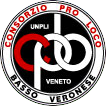GEOGRAPHY
Casaleone lies at 40 km south-east of Verona, next to Grandi Valli Veronesi. Its surface is of 38,29 km² and it is located at an altitude of 16m above sea level. Its fractions are: Venera, Sustinenza, Borghesana and Facciabella. A wide section of its territory is framed between river Menago and river Tregnon. It borders the comuni of Gazzo Veronese, Sanguinetto and Cerea.
ETYMOLOGY
In 1145 the town was called Casalevum, as recorded on some documents, later in 1180 it became Casalaurnus in the fief of Sanbonifacio, Casalavoni in 1184, Casaluponis in 1224 and Casalavon around the 1400s and the 1500s. It can be easily deduced that the town’s name is made of the two words casa (house) and leone (lion). In 1867 besides the name there is an emblem depicting a house and a lion.
HISTORY
Through the Iron Age, up until the first century b.C. the territory of Casaleone was apparently uninhabited, furthermore there is scarcity of evidence and documentation, probably due to the frequent floods suffered by this swampy area. Only after the arrival of the Romans and their Centuriation of the land did the town’s population start to grow, thanks to land clearings and reclamation. According to the archaeological findings, it is safe to assume that the first settlements were no more than humble farms and their little to medium surrounding property
ies. The only building recognizable as a rural Villa is the one inside which a valuable Roman treasure was found: the closet of the Venera, in the area of the same name. Another Roman treasure of Casaleone is the “Tesoretto di Sustinenza”, probably buried in 50 b.C. Today, it is exhibited in the museum of Castelvecchio in Verona. After the fall of the Roman Empire and the floods caused by the Breach at Cucca of 580, the area was turned into a marsh once again. It is only thanks to the effort of the land and owners, especially the clerical ones, that an intensive work of land reclamation could take place. The first document to record the existence of the village of Casaleone dates back to 1104. With this document the countess Matilde di Canossa bestowed upon the monastery of San Benedetto di Polirone the property of Casaleone, fief of the Sanbonifacio. Around the 1300s and 1400s there appeared the eminent families whose name would be forever bound to Casaleone: the Rangoni and the Dal Verme family. Once Alvise Dal Verme rebelled to Venice in 1437, he was stripped of titles and his lands were confiscated. The Venetian domination helped with the population growth and the agricultural development, with greater intensity through the fifteenth and sixteenth centuries, in that age the presence of the following noble houses was recorded: Serego Alighieri, Morandi Rizzoni, Canossa, Sanguinetti, Cagalli, Basadona, Michiel and Boldieri. Casaleone faced a hard time when its lands were scourged by epidemics, famine and the invasion of the Napoleonic troops. With the following Austrian domination the town recovered its autonomy and its state of Comune, under the jurisdiction of Sanguinetto. The annexation to the Kingdom of Italy, after the Third Italian War of Independence was welcomed by Casaleone’s inhabitants with resignation ad contempt.
ART
The houses lined up on the road sometimes give space to some prestigious builiding once inhabited by the nobles of Casaleone, like the three-story palace Sangueneda, with its adorned interiors. Not far from the palace there is the oratory of Sant’Antonio da Padova, built in 1663. At the centre of the town there is the parish of San Biagio, completely rebuilt in 1885 in Lombard Neo-Gothic style, inside it there is a beautiful baroque main altar of 1639 and an ancient wooden statue portraying San Biagio. In Sustinenza, the three-nave church of San Giacomo was built in 1946 on the ruins of the previous sixteenth-century one, destroyed during the Second World War, inside it there is a splendid painting by Brusasorzi. South of Sustinenza there is the Borghesana estate, interesting due to the complexity of its buildings such as the country house Villa Michiel Romanin, the colonnades, the stables and the wide yard. Always in Sustinenza there is Villa Serego Alghieri with its sober ornaments. Also interesting are: Corte Sanguinetti, surrounded by tall walls and a red marble portal of the 1500s adorned with the emblem of the noble family, Corte Morando-Cossali in Palazzone, building provided with a looming dovecote tower, Corte Boldieri-Loredan Canossa in Castellazzo of which only remains the manor house with its frescoed attic, Corte dominicale Boldieri Canossa in Castellazzo, a quadrangular building with an oratory of the 1700s dedicated to San Francesco di Paola, and finally villa Taidelli, with its renaissance frescos. Other buildings worth of mention are Palazzo Malaspina, Palazzo Cagliari, Villa Colombara, Palazzo Bergamasco and Corte Ravagnana.
ECONOMY
The several farms around Casaleone, facilitated by a fertile soil with no lack of water, specialised in the production of vegetables, tobacco and fruit. The most important production is the radicchio rosso di Verona, today called “oro rosso di Verona” (red gold of Verona), esteemed across the nation and widely exported in several European countries, recognized as PGI since 2008.
Casaleone, together with Cerea, Sanguinetto, Concamarise, Bovolone and Nogara is part of the so-called area of the artistic furniture, or better of the Classic Decor. The several local workshops manufacture custom furniture in traditional style and restore precious historical tokens. There is plenty of thriving industrial activitiy as well, specialized in trade and food.
